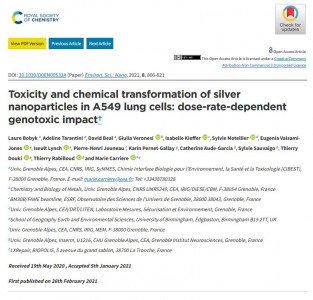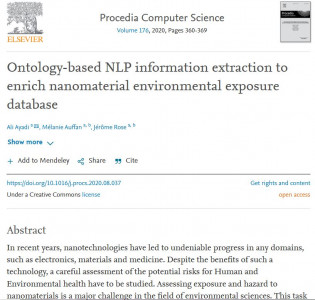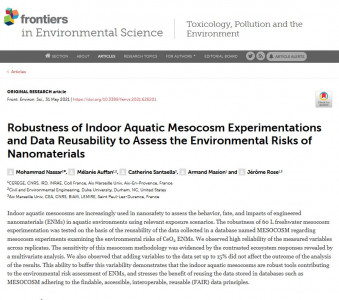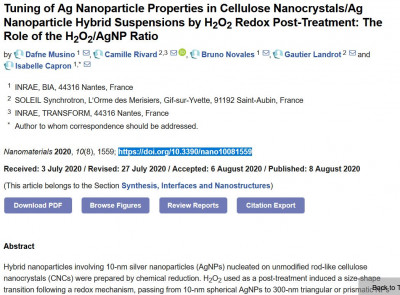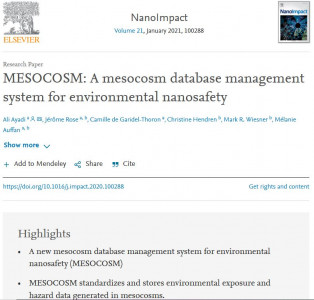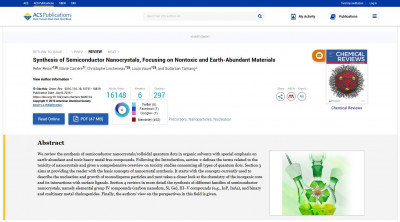Silver nanoparticles (Ag-NPs) are widely used as biocides, leading to contamination of the environment and possible adverse effects on humans. Recent studies revealed that the cellular response to acute exposure to Ag-NPs differs from the response to chronic exposure, although we currently lack systematic studies comparing responses to different dosing regimens.
Read More
Addition of titanium dioxide (TiO2) (nano)particles into photocatalytic paints represents a promising alternative aiming to mineralize gaseous pollutants, such as volatile organic compounds (VOCs) into innocuous species (H2O and CO2). Despite important industrial and economic benefits, some concerns were raised regarding the risks associated with nano-objects and their human and environmental impacts.
Read More
In recent years, nanotechnologies have led to undeniable progress in any domains, such as electronics, materials and medicine. Despite the benefits of such a technology, a careful assessment of the potential risks for Human and Environmental health have to be studied. Assessing exposure and hazard to nanomaterials is a major challenge in the field of environmental sciences.
Read More
Indoor aquatic mesocosms are increasingly used in nanosafety to assess the behavior, fate, and impacts of engineered nanomaterials (ENMs) in aquatic environments using relevant exposure scenarios.
Read More
In this study, we investigate the interactions between the cellulose surface and Ag nanoparticles (AgNPs) for the purpose of manufacturing hybrid nanomaterials using bacterial cellulose nanocrystals (BCNs) as a model substrate. We focus on the role of the BCN surface chemistry on the AgNP nucleation obtained by chemical reduction of Ag+ ions.
Read More
Hybrid nanoparticles involving 10-nm silver nanoparticles (AgNPs) nucleated on unmodified rod-like cellulose nanocrystals (CNCs) were prepared by chemical reduction. H2O2 used as a post-treatment induced a size-shape transition following a redox mechanism, passing from 10-nm spherical AgNPs to 300-nm triangular or prismatic NPs (AgNPrisms), where CNCs are the only stabilizers for AgNPs and AgNPrisms.
Read More
In this paper, we report the construction of one of the first centralized mesocosm database management system for environmental nanosafety (called MESOCOSM) containing experimental data collected from mesocosm experiments suited for understanding and quantifying both the environmental hazard and exposure.
Read More
Wastewater Treatment Plants (WWTPs) are a key pathway by which nanoparticles (NPs) enter the environment following release from NP-enabled products. This work considers the fate and exposure of CeO2 NPs in WWTPs in a two-step process of heteroaggregation with bacteria followed by the subsequent reduction of Ce(IV) to Ce(III). Measurements of NP association with solids in sludge were combined with experimental estimates of reduction rate constants for CeO2 NPs in Monte Carlo simulations to predict the concentrations and speciation of Ce in WWTP effluents and biosolids.
Read More
We review the synthesis of semiconductor nanocrystals/colloidal quantum dots in organic solvents with special emphasis on earth-abundant and toxic heavy metal free compounds. Following the Introduction, section 2 defines the terms related to the toxicity of nanocrystals and gives a comprehensive overview on toxicity studies concerning all types of quantum dots.
Read More
With the goal to improve their photostability, InP-based QDs are passivated with three types of inorganic shells, namely (i) a gradient ZnSexS1−x shell, (ii) an additional ZnS shell on top of the gradient shell with two different thicknesses (core/shell/shell, CSS), (iii) an alumina coating on top of ZnS.
Read More









